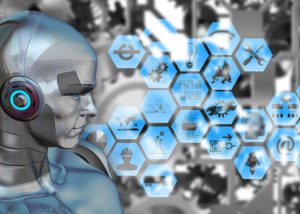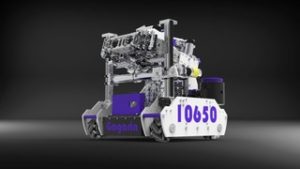 Robots and automation are changing the face of almost every industry. According to the Brookings Institution, a global research firm, more than 25% of jobs in the US are experiencing high levels of disruption due to automation. PricewaterhouseCoopers found that robots could replace 20 million manufacturing jobs by 2030.
Robots and automation are changing the face of almost every industry. According to the Brookings Institution, a global research firm, more than 25% of jobs in the US are experiencing high levels of disruption due to automation. PricewaterhouseCoopers found that robots could replace 20 million manufacturing jobs by 2030.
The reason? For the most part, robots can provide more accurate and efficient services, reducing errors, labor costs and time. Robots never ask for time off, for example. And in industries like medicine, where ideally the margin for error is close to zero, robots can deliver precision. These machines also deal with zero levels of fatigue, emotion or stress.
Here are some general benefits of robots in any industry:
- Able to conduct operations without an assistant.
- Adaptable to perform different types of tasks.
- Programmed or reprogrammed easily and to “learn” quickly.
- You can work 24 hours a day, 7 days a week, without interruptions.
- May perform certain hazardous or hazardous work that poses a risk to humans.
Although many jobs may be lost due to automated systems, new fields of work are also emerging. The need for computer engineers and AI (artificial intelligence) experts is growing. No matter how “smart” a robotic system is, a human is needed to program and repair it.
For those interested in working in the areas of automation and robotics, experience with programming and electronics is essential. Here are some examples of different types of projects that can be researched or considered to gain more insight into how robotics programming works and why. Several how-to videos and instructions on these projects are available online to learn more. Just type the project name below (like “Bluetooth-controlled robotics”) into a search engine.
Mobile robotics use Dual Tone Multiple Frequency (DTMF) to control the robot's actions. DTMF is simply the tone you hear when dialing numbers on your cell phone. Each number in the dialer can be assigned a different frequency and be used to manage a robot's movement. As you build this project, you will learn about the concepts behind DTMF technology, the performance of microcontrollers, and programming.
What is necessary:
- Microcontroller – Functions as the robot’s brain and controls the voltage supplied to the motors
- DTMF Module – It is placed on the robot and connected to the cell phone via an AUX cable
- DC Motors – These are used to drive the robotic vehicle based on the output of the microcontroller
Voice-controlled robotics use speech or voice recognition to recognize the words of a spoken language. Speech recognition is typically used to operate a device, execute commands, or write without needing to use a keyboard, mouse, or press keys. These programs are widely used in applications such as Maps, Smart Assistants, Alexa, etc. A Wi-Fi or internet connection is required between the robot and the user.
What is necessary:
- Microcontroller – Serves as the robot’s brain and controls the voltage supplied to the motors
- Bluetooth module – It is installed in the robot and serves to establish a communication flow between the robot and the user
- DC motors – These are used to manage the robotic vehicle based on the production of the microcontroller
- Android application – Must be combined with speech recognition software so that the system understands voice commands
Bluetooth-controlled robotics involves operating robots according to signals transmitted from a smartphone, via an Android app and Bluetooth interface. This means that Bluetooth communication is used to form a connection between the user and the application where a microcontroller will be used to process the signals.
What is necessary:
- Microcontroller – Functions as the robot’s brain and controls the voltage supplied to the motors
- Bluetooth module – It is installed in the robot and used to establish a communication channel between the robot and the user
- DC motors – These are used to manage the robotic vehicle based on the production of the microcontroller
 Gesture-controlled robots involve human-machine interaction and essentially are where a robot is controlled by manual actions. In this case, an accelerometer sensor can be used to operate the robot's movement, which then “identifies” the progress of the hand movement along three axes.
Gesture-controlled robots involve human-machine interaction and essentially are where a robot is controlled by manual actions. In this case, an accelerometer sensor can be used to operate the robot's movement, which then “identifies” the progress of the hand movement along three axes.
What is necessary:
- Microcontroller – Serves as the robot’s brain and controls the voltage supplied to the motors
- ADXL 335 – It is the accelerometer sensor that can be used to detect hand gesture
- DC Motors – These are used to manage the robotic vehicle based on the output of the microcontroller
Sensors are an essential component used in most robotics projects. By conducting this project, it is possible to understand synthesis, calibration and testing. Using IR sensors, identify obstacles and program a robot to support or avoid them. IR sensors can detect the infrared rays that will be released from obstacles and use them to send signals to the microcontroller.
-
What is necessary:
Microcontroller – Acts as the mind of the robot and controls the operation of the motors - IR sensors – These are installed on the robot and are used to detect objects in the path and send signals to the microcontroller
- DC Motors – Will be applied to operate the robotic vehicle based on the output of the microcontroller
Autonomous robots can operate on their own, independent of any controller. This project involves programming a robot to respond to external stimuli. For the robot to move simultaneously, an Arduino board programmed in a defined path is applied. This acts as the “mind” of the robot and prepares the data coming from the IR sensors. Arduino is an embedded method that acts as a brain for thousands of projects, from normal objects to complex scientific instruments that can be used to take over Arduino architecture and programming.
What is necessary:
- Arduino Uno – Acts as the brain of the robot and signifies the signal coming from the IR sensors
- IR sensors – These are installed on the robot and are used to detect the objects in the path and transmit signals to the Arduino Uno
- DC Motors – These are used to drive the robotic vehicle based on the output of the microcontroller

